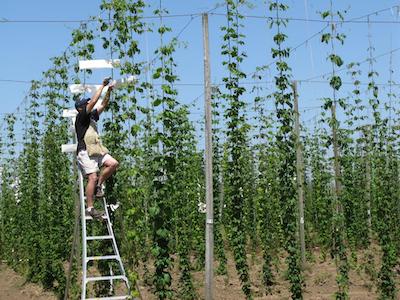Growing Hops
By Brad Willet, Fairfax Master Gardener Intern
 With September comes the feelings of fall, the turning leaves, the cooler weather and some preparations for getting summer gardening tasks accomplished before the fall season. Another thing that falls in September is Oktoberfest. During the two-week celebration of Oktoberfest in Munich, Germany each year, there are roughly 1.93 million gallons of beer consumed by the roughly 6.3 million attendees. Here in Virginia, there are about 290 craft breweries selling roughly 1.7 gallons of beer per 21+ adult. That’s a LOT of beer. So, what better chance to talk about growing hops.
With September comes the feelings of fall, the turning leaves, the cooler weather and some preparations for getting summer gardening tasks accomplished before the fall season. Another thing that falls in September is Oktoberfest. During the two-week celebration of Oktoberfest in Munich, Germany each year, there are roughly 1.93 million gallons of beer consumed by the roughly 6.3 million attendees. Here in Virginia, there are about 290 craft breweries selling roughly 1.7 gallons of beer per 21+ adult. That’s a LOT of beer. So, what better chance to talk about growing hops.
Hops (Humulus lupulus) is one of the essential aromatic and herbal elements in the production of beer. Historical uses for hops have transcended empires and continents. It was considered an edible by ancient Romans, then used by brewers in France and Germany to preserve their beers in the 9th and 10th centuries. Hops has been grown in the U.S. since the early Massachusetts Bay settlement allowed a 45-acre plot to establish a crop in 1648. It remained the largest supplier of hops to the colonies until the mid-1800’s when it was overtaken by New York.
Since the 1700’s, Virginia and Thomas Jefferson were keen on its cultivation for a special Virginia brew. However, it eventually started to shift to the West Coast leading to the states of Washington, Oregon and Idaho to overwhelm the production of the crop. However, in the surge in craft brewing in the state, hops production for the hobbyist and the commercial grower has continued to rise. Since 2014, Virginia Cooperative Extension (VCE) has begun to track the scope of this growing industry in Virginia, and much of the production is centered around Northern Virginia areas. However, there are hops growers popping up all across the state.

Hops flower
Full sun is the best light for them, but they can handle and even thrive in part shade. They are relatively pest free but can be susceptible to downy mildew, spider mites and occasionally aphids. However, a well-balanced dose of predatory and beneficial insects like ladybugs, praying mantis, or mite predators will likely take care of them. They like to grow in a well-drained sandy loam soil, and a pH ranging between 6 and 7.5 is ideal. However, I planted mine in an ill-prepared bed, and they couldn’t be happier. All hop rhizomes purchased are female, so there is no real concern of cross pollination. However, it’s best to separate different varieties by at least 7 feet if you have the room. Additions of compost, mulch and a well-balanced fertilizer can help during the growing season.

Hops growing on supports
Virginia has seen a significant resurgence in the cultivation of hops and is within the optimal hop growing zones between the 35th and the 55th latitudes. Virginia is at the southern end of this range, with a dormant cold period. The humid climate that permeates the Virginia landscape does have some drawbacks, specifically shorter day length, disease pressure and humidity; only certain varietals have any major success here. Hops also needs to be harvested by hand and can be quite labor intensive. The main varieties grown (at least commercially) in Virginia seem to be Cascade, followed by Zeus, Chinook and Galena. In comparison, the hops grown in the Pacific Northwest are easily four times the yield per acre than can be grown here in the Mid-Atlantic. However, with more than 200 (and counting) breweries in Virginia alone, many local brewers want to get their hands on local ingredients.
Throw some barley into your hop field and you have your makings of a great locally sourced, Virginia “terroir” enhanced home brewing opportunity. In celebration of Oktoberfest and general merriment, raise a glass (if of legal age that is) to a very celebrated beverage whose flavor is enhanced by this easily cultivated plant.
PROST!!
**NOTE** Hops can be toxic to dogs, either fresh or dried, so be sure to keep these in an area where dogs will not be tempted to eat or nibble on them.
Resources
• 2018 Hop Grower Survey: Results, Publication SPES-131NP, Virginia Cooperative Extension
• Growing Hops in the Southeast, Jeanne Davis, Dept. of Horticultural Science, North Carolina State
University
• Helpful Information About Hops, The Thyme Garden Herb Company
• Oktoberfest 2019 – A review in numbers, I Am Expat
• Very Pleased: A Quality Oktoberfest for the Whole Family, 2019 Official Review, Oktoberfest.de
• Virginia’s Craft Beer Sales & Production Statistics, 2019, Brewers Association